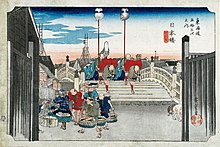Edo
Edo (江戸, edo?, "estuary"), sometimes romanized as Jedo, Yedo or Yeddo, is the name given to the current city of Tokyo until 1868, the year of the Meiji Restoration. Edo was the seat of power of the Tokugawa Shogunate, which ruled Japan from 1603 to 1868. During this period the city grew to become one of the world's great cities and the site of an urban culture centered on the notion of a "floating world.".
History
Although there were settlements on the hills above Tokyo Bay for several centuries, the first major milestone in the city's history was the construction of Edo Castle in 1457 by Ōta Dōkan, during the Muromachi Period. In 1525 the castle was taken over by Hōjō Ujitsuna. However, it was during the Azuchi-Momoyama period that Edo began to play an important role within Japan itself; by then it had already become the main center of the Kantō Region.In 1590 Ieyasu Tokugawa's troops took control of Edo Castle, making it his headquarters. At that time the settlement that surrounded the fortress was made up of a few huts, but Ieyasu undertook the raising of a new city by establishing warriors and craftsmen, as well as undertaking a reinforcement of the castle's defenses. In 1606 the outer enclosures of the Castle were completed.
Tokugawa Period
In 1603 the Tokugawa shogunate was officially established, also beginning the Edo Period. Despite the fact that the Emperor's residence remained in Kyoto and this was the official capital of Japan, in Edo was the real political power and therefore it functioned as the de facto capital of the country.
After the establishment of the new regime, other feudal lords (Daimyō) from all over the country began to establish residences (町奉行, Sankin kōtai ?) in Edo, where their wives and children also resided. Edo Castle, converted into an impregnable fortress, it became the residence of the Shōgun and the main center of power for the entire country. Around the castle an important urban nucleus was formed, made up of official residences, samurai districts and commercial districts. By 1721, Edo had an estimated population of more than 1,000,000 inhabitants, being at that time the largest city. the world. By the end of the 13th century, the city's commercial districts alone had a population of over half a million people. Due to the presence of numerous merchants and businessmen, Edo also became an important economic and culture of the Shogunate.
Edo was also established as a first-order communications center, being the place where the five main routes that linked the city with the rest of the country were concentrated. Despite Ieyasu Tokugawa's initial interest in promoting trade relations with foreign countries, Edo never became a port for foreign trade, partly because of the preference foreign traders had for the southern ports of Kyūshū. The country's subsequent isolationist policy would undo this possibility. During this time, Edo was repeatedly devastated by fire, the Great Meireki Fire of 1657 being perhaps the most destructive of all that ravaged it. In 1668 another great fire ravaged the city for at least 45 days. It is estimated that about 100 fires of various kinds ravaged the city during the Edo Period. These became so common that they became known as the "Edo flowers".
In 1855, as a result of the Great Edo Earthquake, a large part of the urban core was seriously affected.
In 1868, with the crisis and disappearance of the shogunate, the city was renamed "Tokyo", which in Japanese means capital of the East. During the Restoration, Emperor Mutsuhito traveled to Tokyo for the first time. time and settled there effectively. In this way, the city eventually became the capital of Japan.
Government and administration
Edo was administered by two City Magistrates (町奉行, Machi-bugyō ?), each of which had under its jurisdiction one of the halves of the urban nucleus. These magistrates were directly in charge of the police and a fire service (町火消, Machibikeshi?). There were also other senior officials in charge of various matters related to the administration: construction, buildings, urban land, supplies, infrastructure, military supplies, etc.
Panorama
Contenido relacionado
Rostock
Matanza-Riachuelo River
Frankfurt Parliament


